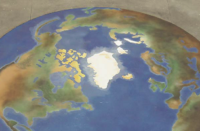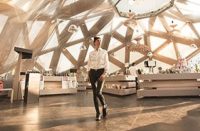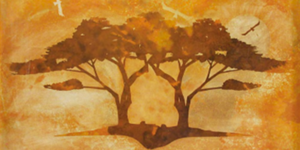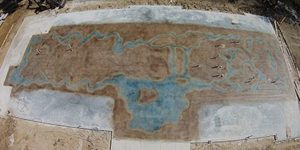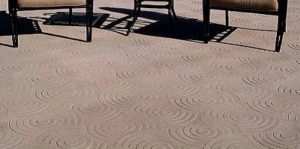 |
 |
 |
Volcanoes oozing hot lava … tiki torches burning on the beach … tribal tattoos … constellations sparkling in the sky. These things aren’t exactly what you’d expect to see in decorative concrete jobs in Ohio, but then again Gregory Mata’s work is far from ordinary.The Cleveland native is incorporating actual artwork into concrete surfaces with outstanding results. He’s also experimenting with different materials and media — such as integrating fiber optics into flatwork and countertops — in scenes that light up almost as brightly as the faces of people seeing them for the first time.
Mata credits much of his success to his think-out-of-the-box mentality. “We’re doing things not many other companies are doing,” he says. “I feel very honored to be a part of many of these projects I’m involved with.”
 |
 |
 |
Humble beginnings
Mata’s father was a cement contractor and a labor union official. Working with his dad landed Mata positions on large downtown projects during his years studying electrical engineering at Cleveland State University. “I got a huge amount of exposure that most people don’t get the chance to experience,” he says about those summer jobs. “I got to see firsthand what makes large projects flow and function.”
When the time came for his dad to retire, Mata yearned to break free and start his own company. “I was completely burned out on regular gray flatwork,” he says. He was more interested in concrete and masonry work, particularly structural repair. In 1995, he founded Cutting Edge Construction, which was soon one of the largest nonunion companies in Richfield, Ohio, that handled structural repairs for commercial buildings.
Work was steady but not very stimulating, he admits. He began to hear rumblings about something called “decorative concrete,” although no one he knew was doing it. Then came the postcard. Someone was offering a two-day class in nearby Columbus. He signed up.
 |
 |
 |
“I couldn’t believe what I was seeing,” he remembers about that fateful class. “Right then and there, my interest in concrete work was right back to what it was when I was a kid.” He sought out suppliers and entered the decorative arena full throttle.
By the late 1990s, his business had largely shifted from masonry restoration to decorative concrete. In 2000, he changed the name of his company to Cutting Edge Decorative Concrete. “It’s important to have the right name,” he says.
The here and now
Today, Cutting Edge employs between five and seven employees, and the company’s handiwork stretches beyond the borders of Ohio. Its services include concrete countertops, stamped concrete, illusional concrete art, water features, acid staining, resurfacing and stenciling, patios and pool decks, outdoor fireplaces, basement floors and Illumi-Crete, Mata’s trademarked name for the company’s fiber-optics features.
“Outdoor entertainment areas are probably our specialty,” he says. “I like to put together big components to accomplish the ultimate wow factor.”
 |
 |
 |
Case in point: One of his latest projects involved a family who has a timeshare in Hawaii. While there, they can see the beaches of Diamond Head. They wanted a similar view simulated at their Ohio homestead.
Alongside stamped concrete, Mata created an area that looks like a cliff overlooking the ocean at Diamond Head. There are fire dancers on the beach, juggling their lit batons, with the ends containing fiber optics for effect. A sunset fades over the top of a mountain and blends into a starlit night sky that shines with the homeowners’ zodiac constellations, Taurus and Pisces.The homeowners also requested a water feature with fiber optics. Mata created a volcano with faux hot lava spewing out from the top and fiber-optic points of light on the sides. At the bottom of the volcano, pool lights shine through bubbling water and a fog machine creates a convincing haze. “It looks like hot things are going on,” Mata explains.
Gone to the dogs
These homeowners also wanted something special out front: another water feature, to commemorate their beloved Dalmatians. To accomplish this, Mata first had to locate a fire hydrant — no easy feat, as it turned out — to be used as a fountain. “It seemed like such a natural. Dalmatians, fire truck, fire hydrant,” he says.
After several calls to fire departments and recycling centers with no luck, he finally hit pay dirt with some fellow who was in the process of replacing old hydrants. He ended up getting a 1923 model for free.
He sandblasted and repainted the old fireplug, which served as the centerpiece for the Dalmatian shrine, and painted a manhole cover around it. As part of the stamping job, he included a scene with a cracked and leaking pipe, with one of the dogs shaking off water and the others just hanging out, watching. “When we started the job they had three Dalmatians. About halfway through, they adopted a fourth and wanted him in there, too,” Mata says. For accent, fiber-optic lights are arranged sporadically around the dogs.
 |
 |
 |
But the project didn’t stop there. For a signature touch, Mata cast a rubber stamp made from each of the dogs’ paw prints. Around the border of the driveway, his crew stamped a pattern that looks like a dog ran through wet cement. “The owners know which dog’s footprint is whose,” he says. “It made the finished product very special to them.”
Adding that something special is part of what stands out about Mata’s work. “We’ve always done that,” he says. “We try to do something unique with every project by including something that’s not available at the local supply store.”
He says that he’s created a number of custom stamps for people because there are only so many tools readily available. “My mind is always whirling with things that could be. I like to look for things and see how I can make them do something they weren’t made to do.”He also likes to surprise his customers by giving them something they didn’t directly pay for, like a birdbath made out of leftover concrete or a bench that bears the same stamping pattern as a patio. “My customers appreciate that little something extra. It’s always a big hit,” he says.
He urges others in the business not to be afraid to try something new. “Explore the possibilities,” he says. “Create things that have yet to be created. Push the envelope. Push yourselves. Push the industry. There are so many things that can and will be done. It’s just a matter of trying. Ask the customer to give you a chance.”
But above all, don’t sell yourself short. “Give yourself the credit that’s due and charge what you’re worth. You deserve to get paid for what you produce. There’s an incredible amount of work that goes into producing these things. You need to be fair to yourself as well as your customer.”

